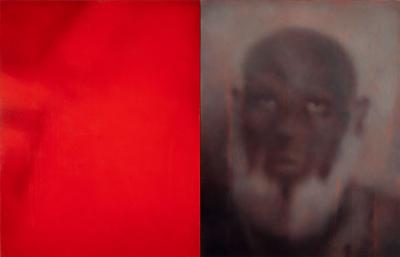‘Politically Incorrect’ Taps Hot Buttons

A political season with many candidates hoping to distinguish themselves in the race for their party’s nomination has created little light but a great deal of heat in American discourse. Most of the smoke of the campaign is traveling well north and west of here (the New York State federal primary election is not until April 18). Yet many artists on the South Fork and farther afield have taken note of the acrimony, and their reactions now hang at the White Room Gallery in Bridgehampton.
“America on Fire: A Politically Incorrect Show” features the work of several South Fork artists. How “politically incorrect” the show is may be up to interpretation, but it does address some current hot-button issues affecting our nation.
It is clear from the coverage of the early primary states and from polling information in general that a vocal group of Americans is angry and wants change. Mark Seidenfeld, who organized the exhibition, said in a statement that while people in his circle seem agitated by the state of politics in America, he sees it more as a reflection of anger at reality. The state of politics is the symptom, not the problem, in effect.
After deciding that artists might best illustrate the fissures in contemporary culture, he issued an open call for them to submit their responses.
Given the aims and themes of the exhibition, Anna Jurinich’s “Angry Planet,” an acrylic rendering on paper of a dense thicket of humanity all in mid-yowl, is most on point. The faces, all smashed together to fit on the orb, sometimes take on snake or worm-like qualities, craning their cartoonishly long necks to escape the fray or get in the face of someone else. It is reminiscent of political talk shows. Although some may have some slightly feminine features, almost all of these screaming faces seem to belong to white men.
Geoffrey Stein’s “Trump Bankruptcy Collage” and “Madoff,” works he made with newsprint, paint, and pencil drawing, have a pulled-from-the-headlines theme and point to some of the more infamous financial newsmakers of the past decade. Bernie Madoff was sentenced to 150 years for financial malfeasance on a grand scale that involved many prominent clients and wiped out their fortunes. Donald Trump’s campaign for the presidency has been marked by oft-rebroadcast and printed slurs on minorities and women.
It is not clear whether the artist is taking a critical look or not in these pieces. His collages from the series “Irrational Exuberance” contain both reformers and rogues. While it’s hard to imagine that Mr. Stein is neutral to Mr. Madoff, Mr. Trump’s popularity attests that many see him as a hero and reformer of a broken system.
But the clear star of the show is gun imagery. Pieces by Mr. Seidenfeld, Rossa Cole, Eric Ernst, Charles Waller, and others use the shape of guns or images of them to send mixed messages of glorification, menace, and tragedy. Mr. Seidenfeld’s peace sign formed out of toy guns could be taken as an ironic or a sincere sentiment. Many think guns and the implied threat of violence are necessary for peace; others would find the two at cross purposes.
Mr. Waller’s dolls with guns play on childhood innocence in games like guns and robbers, and the victimhood of children with the rise of gun violence in schools. Mr. Cole tackles the same themes in his sculpture “AR-15,” composed of children’s books. In Mr. Ernst’s piece, a nod to James Bond’s opening film credits is evident, and the stylistic glorification of violence in those frames feels much more sinister taken out of context.
Another recurrent theme is the value of guns and money over human life. Michael Cardicino’s Monopoly figures shrugging on the steps of the New York Stock Exchange, with bags of money and skulls alternating at their feet and then collected in a deep subterranean vault below, critiques contemporary values. That the number of human skulls outnumbers the money bags in the vault by a large factor underlines just how much human sacrifice must be tolerated to amass large reserves of wealth, money that may have saved lives if distributed more evenly across societies and classes. A shout-out to Bernie Sanders seems implied here.
Mr. Waller also offers a contribution to this theme in his “Dollars and Nonsense” sculpture of a skull embossed with a facsimile of United States currency and Groucho Marx glasses.
Aside from these recurrent themes, there’s a lot more in terms of message and art by artists such as Jeff Muhs, David Geiser, Paton Miller, David Slater, Peter Spacek, Camille Perrottet, Dennis Leri, June Kaplan, Kat O’Neill, Eva Iacona, Sue Zola, Caren Sturmer, Barbara Bilotta, Mark Zimmerman, Stephen Mannino, Melissa Hin, Beth O’Donnell, Suprina Kenney, Sally Breen, Ruby Jackson, Gina Gilmour, Abby Abrams, and Bryan Greene.
It is worth bringing someone with you to discuss the show afterward. It’s that kind of exhibition. It will be on view through Sunday.
